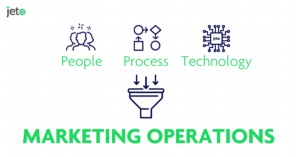Our CEO, Alexandre Pelletier, defines marketing operations as: “The art and science of connecting the right technology and having the proper processes, people, and training so that it can all work well and cohesively.”

We decided to take it one step further – what do people, processes, and technology look like in marketing operations?
… What types of people do you need on your campaign operations team?
… How do you socialize and enforce processes with your team?
And our personal favorite, what is in your MarTech stack?
We discussed these questions and more with MERGE’s VP of Demand Generation, John Francis.
As a Marketo Certified Expert and former Marketo consultant, John brings 20+ years of experience in the marketing industry. With firsthand experience building his own campaign operations team, we wanted to get his unique perspective on how he approached building out his team, what’s in his MarTech stack, and best practices when it comes to executing processes.
Finding the right PEOPLE
Q: What does an ideal campaign operations team look like to you?
I start mapping out the team before worrying about titles – I find it helpful to ask myself “who do I need from a minimal viable product standpoint?” This helps me identify the key players and I go from there.
At MERGE, our campaign operations team looks something like this:
- Content writers
- Campaign managers
- Revenue operations managers
- Digital marketing specialists
Q: What are the personality traits you’re looking for in your team?
A: I’ve always been a fan of a jack of all trades.
In campaign operations, you need to be able to do anything, get scrappy, and when you hit a roadblock outside of your swim lane, you’ve got to figure out how to overcome it. I love people who are open to communicating when they do hit a roadblock and don’t sit on it for two weeks.
On the marketing operations side, you need a team player who can collaborate with other teams – someone who’s really good at communication but is also technical and is able to design an approach.
Finally, I love people who support our company values.
Q: Let’s say you had a budget to hire one person, but you also have willing team members who are eager to learn more. Which one would you choose – hire an expert or train a team member?
A: I’d hire an expert.
I want someone who can hit the ground running and bring in their expertise. Although I’m a Marketo Certified Expert, I’m not a Solutions Architect. I don’t have enough time in my day to pass down all that knowledge. We need to move fast and drive results – meaning we need an expert right in the door.
Creating and enforcing PROCESS
Q: Creating processes can be challenging – what is your approach to creating and enforcing processes?
A: I have a bias toward action. I like to get the ball rolling as soon as possible. To begin, we outline the different phases of a campaign.
From here, we identify the different activities that line up under each phase, plus who’s responsible, accountable, consulted, and influences each phase of that phase. This is commonly referred to as a RACI chart.
Although you can’t get rid of gray areas altogether, a RACI chart helps reduce gray areas.
Q: What is your approach to socializing and enforcing processes?
A: To begin, I like to review our defined process and see if any updates need to be made. Regardless of the project, your process must include:
- A feedback loop
- Consistent check-ins with your team and stakeholders
It’s important to ensure the process is working for everyone. In general, when developing processes, I recommend doing it as a team – you’ll avoid blindspots and it will also be a good team-building exercise.
Q: Centralized versus decentralized execution: which do you recommend and why?
A: It depends on the business – you can have a centralized marketing team if your business isn’t that complicated.
In other cases, you have decentralized marketers in a franchise model or a company with several different practice areas or verticals.
The Marketo Admin in the decentralized model focuses on governance and having a center of excellence. At MERGE, we’re a centralized marketing team, which has worked well for our business.
Choosing the right TECHNOLOGY
Q: What’s in your team’s MarTech stack?
A: We have a ton.
The main ones are Marketo, CoSchedule, Terminus, Ahrefs, WordPress, Visible, Typeform, Sitecore, Sprout Social, Hubspot, Meta Business Manager, BrightEdge, Google Search Console, Salesforce, SEMrush, Crossbeam, LinkedIn Sales Navigator, Calendly, Drift, Intercom, and Zoom Info.
Q: Do Campaigns Operations teams need that many Saas solutions?
Some of them might be brought on because of a business need. Some of them, you might be testing because you didn’t necessarily need it or think you needed it. But it turns out it makes your business more efficient in some way.
I just try to stick with technologies that play well together. Native integrations are crucial so that you don’t have to piece things together all over the place. You can just pick and choose the right ones for your business.
Q: How are you using Marketo to scale efforts – especially as it pertains to campaigns?
A: We mainly stick to these three features:
- Program templates
- Global forms
- Global assets
That’s pretty much it. I don’t use tokens very often – I think they’re great for event programs, but personally, I can do just as good without them. We have a large user base, so when we use Marketo, we’re doing a lot of nurture campaigns and so forth.
It gets really exciting when users convert to MQL status – it’s a rewarding moment because you can see your efforts come to life and that marketing had some influence on revenue.
